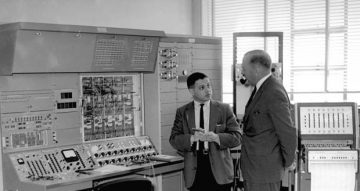
 In an abridged history of computing, digital computers simply replaced analogue computers. Of course, the reality is more complex. In fact, analogue and digital computing developed side-by-side throughout the 1960’s. The two technologies were also combined in hybrids to take advantage of the strongest features of both. Analogue computers are still used today, in particular, to control continuous variables that can easily be measured without digitization, for example, in the control of fluid flow and temperature in an industrial process.
In an abridged history of computing, digital computers simply replaced analogue computers. Of course, the reality is more complex. In fact, analogue and digital computing developed side-by-side throughout the 1960’s. The two technologies were also combined in hybrids to take advantage of the strongest features of both. Analogue computers are still used today, in particular, to control continuous variables that can easily be measured without digitization, for example, in the control of fluid flow and temperature in an industrial process.
Early analogue computers were more advanced than their digital counterparts. In the 1950s, analogue machines were used in industries where non-linear, differential equations were needed to describe complex systems. Avro Aircraft and Boeing were early adopters of analogue computing, using rooms of interconnected machines to solve the huge differential equations needed for flight.

Analogue/ Digital Hybrid
The digital side of this ECE hybrid above was a PDP-9 (Programmed Data Processor from the Digital Equipment Corporation). The analogue side was a PACE. On the left is a cathode ray tube, graphic display and in the center is magnetic tape storage. This system was used by Dr. Donaldson to synthesize and recognize human speech. Two of Dr. Donaldson’s graduate students are working with the hybrid in the photo above.
The ALWAC Comes to UBC in 1959

In the image above Dr. Hull (Mathematics) Dr. Noakes (Electrical Engineering Head), Dr. Wilkinson (Commerce) and Dr. Bohn (Electrical Engineering) are shown with the input/output device of the ALWAC. The ALWAC was one of the first digital computers at UBC. This early digital used 132 vacuum tubes in the design and was programmed and produced output on punch paper tape. This particular computer was only in use at UBC for a few years (1959-1961) because improvements in digital machines were taking place very quickly.

This 1959 article in the Halifax Mail-Star includes a description of a game of tic-tac-toe with the ALWAC.
Computation vs. Simulation
 Professor Avrum Soudack contrasts the two technologies in this way, “The fundamental difference between an analogue computing machine and a digital computer is that the analogue machine does not actually compute, it simulates. An analogue computer or simulator is a device that has the ability to integrate, differentiate, add, subtract, multiply and divide, in real-time. That’s it. A digital computer can be programmed to solve differential equations in a stepwise fashion and it can also be programmed for many other things. It is this versatility that made digital computers ubiquitous. Analogue machines are still the best technology for solving differential equations.”
Professor Avrum Soudack contrasts the two technologies in this way, “The fundamental difference between an analogue computing machine and a digital computer is that the analogue machine does not actually compute, it simulates. An analogue computer or simulator is a device that has the ability to integrate, differentiate, add, subtract, multiply and divide, in real-time. That’s it. A digital computer can be programmed to solve differential equations in a stepwise fashion and it can also be programmed for many other things. It is this versatility that made digital computers ubiquitous. Analogue machines are still the best technology for solving differential equations.”
Dr. Soudack installed the PACE 231R analogue computer in room 348 of the MacLeaod building in 1964 with the support of an NSERC grant. It was used in research for approximately ten years. An investigation of chaos theory was one of the final projects for the PACE. In the topmost photo, Dr. Soudack can be seen on the left demonstrating the PACE to a colleague.
Find out more:
